Euphorbia Mila - description of varieties and rules of care
Among all the variety of indoor flowers, the large-flowered Mila spurge is one of the most popular and outstanding representatives of the Euphorbia family. This plant was named after Baron Milius, who brought it to France in 1921. Consider a detailed description of the type, varieties and rules of home care.
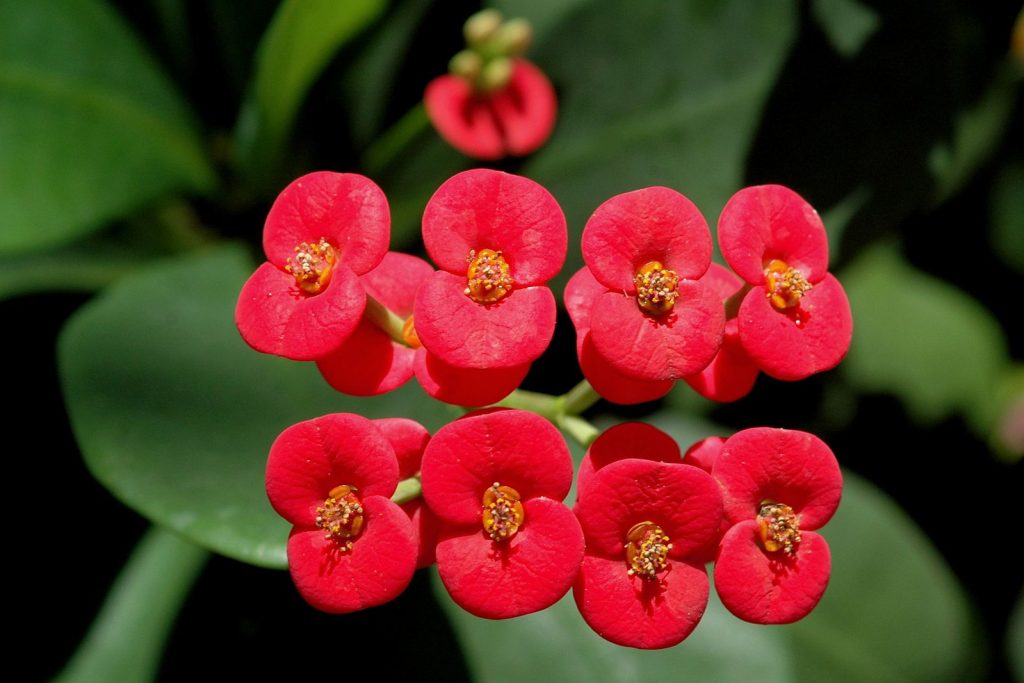
Euphorbia mile omens and superstitions
Characteristic
The botanical name is Euphorbia Milii. The people call the species: Spurge brilliant; Euphorbia is beautiful; Crown of Thorns; Euphorbia Milius.
According to legend, it was from this plant that the crown of thorns was made, put on the head of Jesus Christ.
In its natural habitat, the bush reaches 2 m in height, belongs to perennial succulents with good branching. The birthplace of growth is about. Madagascar, arid regions of Mexico and east Africa.
Euphorbia can be grown as an indoor flower, and the plant also grows well in greenhouses or a greenhouse.
You can distinguish the Mil variety from others by the following features:
- the stem is grayish, slightly ribbed;
- at the top of each shoot, green elliptical leaves of a rich emerald color develop, length 3.5-4 cm, width - 1.5-2 cm;
- under the leaf plate there are two stipules in the form of thorns;
- with age, the leaves crumble, but the thorns remain;
- the greatest decorativeness is represented by bracts, which, depending on the variety, are yellow, lemon, scarlet or orange;
- blooms at different times of the year (spring or summer) - forms inflorescences, consisting of 2-4 large flowers (color pale pink, lemon, fuchsia, bright scarlet, etc. - depends on the variety).
Be careful! Euphorbia secretes a poisonous milky juice, it appears on broken off or cut leaves.
Signs and superstitions
According to popular beliefs, it is generally not advisable to keep spurge in the house, because this is a plant with thorns - and it negatively affects the human aura.
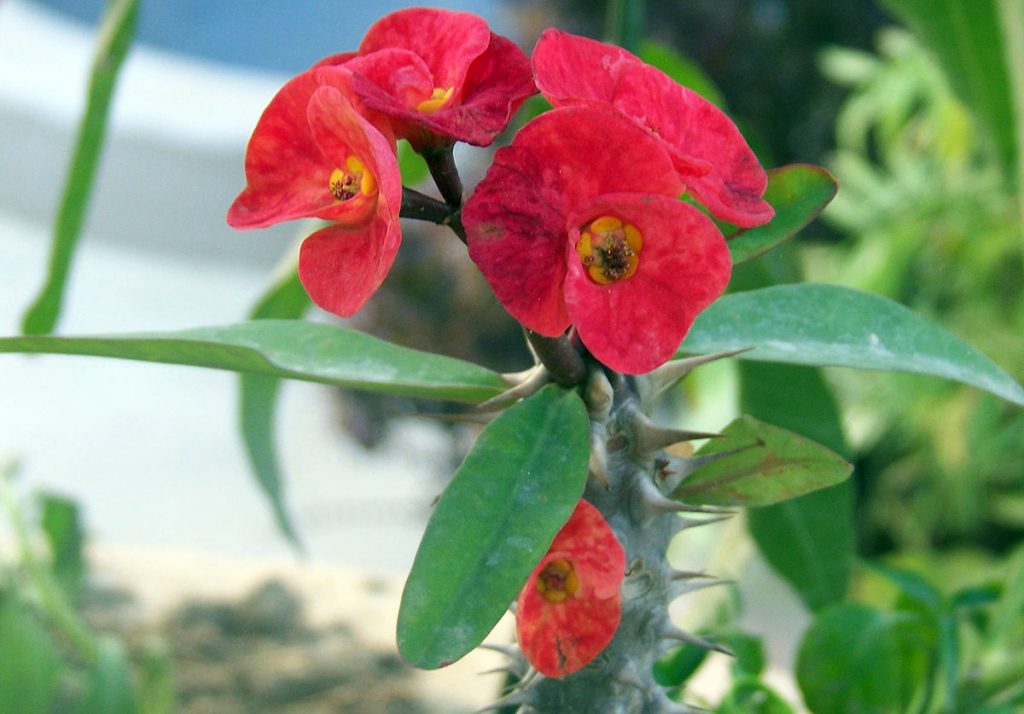
Euphorbia Mile
But, according to another sign, blooming euphorbia attracts positive energy into the house and repels ill-wishers, therefore, it is placed in the hallway or living room, where strangers and acquaintances often come.
Feng Shui science says that such a flower can be placed in any room, with the exception of a bedroom, then its negative meaning is neutralized.
Popular varieties
This decorative culture has several types that have been successfully used in decorating the interiors of houses, offices and apartments.
After reading their description, you can choose the best variety for your home decor.
- King Golden (yellow) is a beautiful flower with yellow bracts. The leaves are emerald, long, sharp at the tips, clearly visible light green veins on the surface.
- Moonlight - leaves are green, smooth, at the top of each erect shoot, yellow bracts with an orange center develop.
- Sakura kiss - euphorbia is distinguished by snow-white bracts with small pink blotches on the surface.
- Bojeri - Develops slender, elongated shoots with bright red or scarlet bracts. It is prized for its abundant flowering in summer and less lush in autumn.
- Natali - bracts of yellow color in different shades (from lighter to darker).
- Lutea is a bushy plant, shoots are densely covered with emerald, long leaves. Stipules of lemon shade develop at their apex.
- Sonora - has beautiful pink bracts.
- Nam Choke is a perennial that pleases with rich red flowers with red-pink bracts all year round. It does not differ in fast growth, therefore it does not require a shaping haircut.
- Chok Seetid is a very decorative variety with bright pink flowers (fuchsia color).
- Antonght - light beige or milky flowers. Under the sun's rays turn pink on the back.
- Look Pet Petay - a very unusual color of the petals - the main color is ivory, pinkish blotches are present.
- Sedthee Mai - The petals are dark pink with a tinge of purple.
- Sunny - double-colored flowers - yellow at the edges, and pinkish inside.
- Chok Kao Chan - the petals have a very thin and rich pink edging, the main surface color is yellow, there are blurry pink spots.
- Tawan mai - the flowers are uniform, scarlet, they look very contrasting against the background of green foliage.
- Miliiana Giallo - flowers of light green or lemon shade. Very bright and unusual.
Purchase and adaptation
You can buy a mile spurge in one of the flower shops - this plant is affordable and not expensive. The average price is from 100 to 200 rubles.
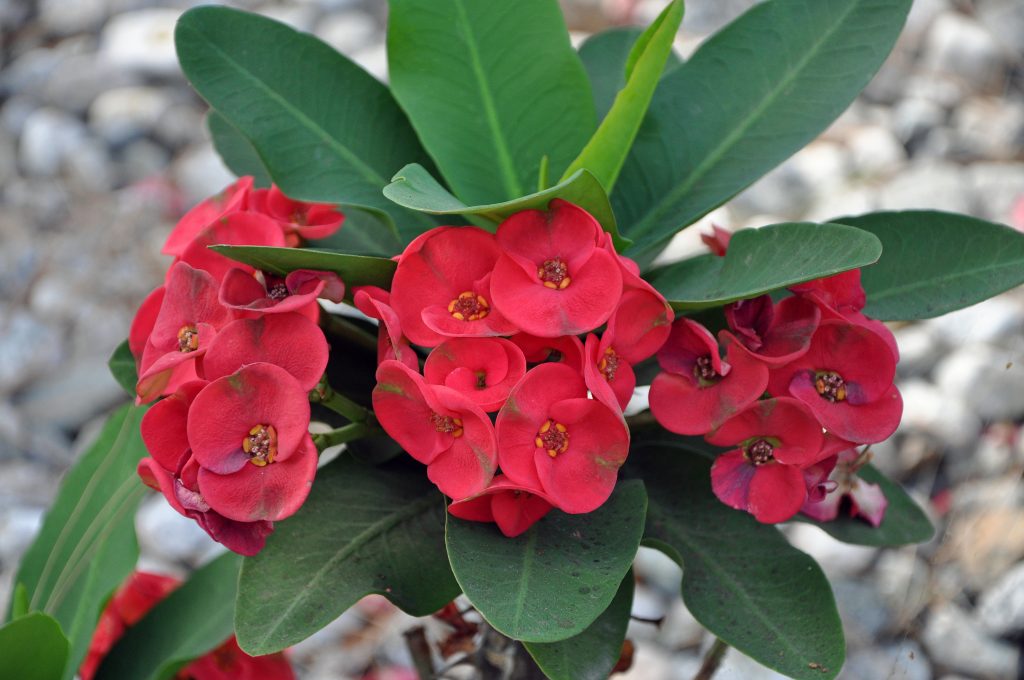
Spurge brilliant
When choosing, you should give preference to grown flowers, which already have well-developed stems, leaves and root system.
When buying, carefully inspect the crown - the main thing is that the stems, buds and leaves are fresh, juicy, without mechanical injury and damage from diseases, pests.
You can determine the condition of the roots by the appearance of the substrate - in healthy plants it is slightly moist, without white or gray bloom on the surface. Also free of mold and acidification.
Newly acquired euphorbia is placed separately from other flowers for three weeks. Such quarantine exposure is necessary in order to understand whether the spurge is sick with something or not. During this time, he will get used to and adapt to indoor growth conditions.
Choice of soil and location
Throughout the growing season, it can be kept in a place where there is diffused lighting for most of the day. Usually placed on the south or southwest window. In the warm season, they are taken out to the balcony or terrace - the spurge loves fresh air. In winter, illuminate with a fluorescent lamp. It is installed at a distance of 50 cm.
This plant is not demanding on the composition of the soil and can fully develop in sterilized garden soil. A purchased substrate for planting succulents and cacti is considered optimal.
You can also plant a flower in a soil mixture prepared by your own hands - they mix leafy, turfy soil and sand in a 2: 1: 1 ratio. Before laying it in a pot, spill it with boiling water, a raspberry solution of potassium permanganate, or ignite it in an oven at a temperature of 100 ° C for half an hour.
Growing conditions
Room milkweed requires at least 8 hours of ambient light per day to grow and bloom fully. With a lack of light, its stems become thinner, elongated, the leaves turn pale, the flowering is not so bright and lush. Poorly tolerates direct sunlight - leaves and flowers quickly fade. Therefore, it is better to keep it where the sun shines in the morning and evening. Shade at lunchtime if necessary.
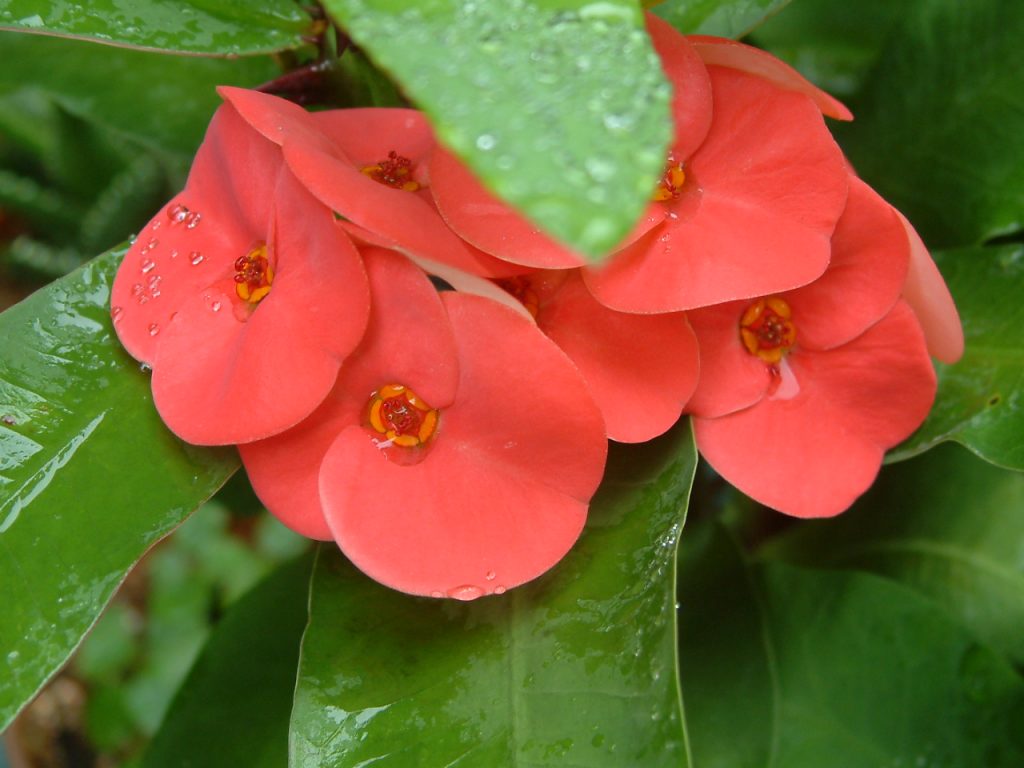
Euphorbia mile home care photo
The plant is not afraid of drafts, but does not tolerate keeping in the cold. The optimal regime in summer is 24-30 ° С, in winter - 16-18 ° С.
In the warm season, the flower can be kept outdoors with protection from wind, precipitation and scorching rays.
In autumn and winter, they are placed near heating devices, this will help to avoid hypothermia of the root system.
The minimum temperature is 14 ° C, if it is lower, the plant will quickly die.
Euphorbia prefers moderate humidity - in the range of 55-60%. Therefore, it is not necessary to spray it. This procedure is carried out once a month for hygienic purposes only, in order to wash away dust and prevent the appearance of harmful insects. Water at room temperature is used for irrigation.
Care
Watering
This plant requires rare but abundant watering. Each time they are moistened only after the soil has dried to a depth of 4-5 cm.
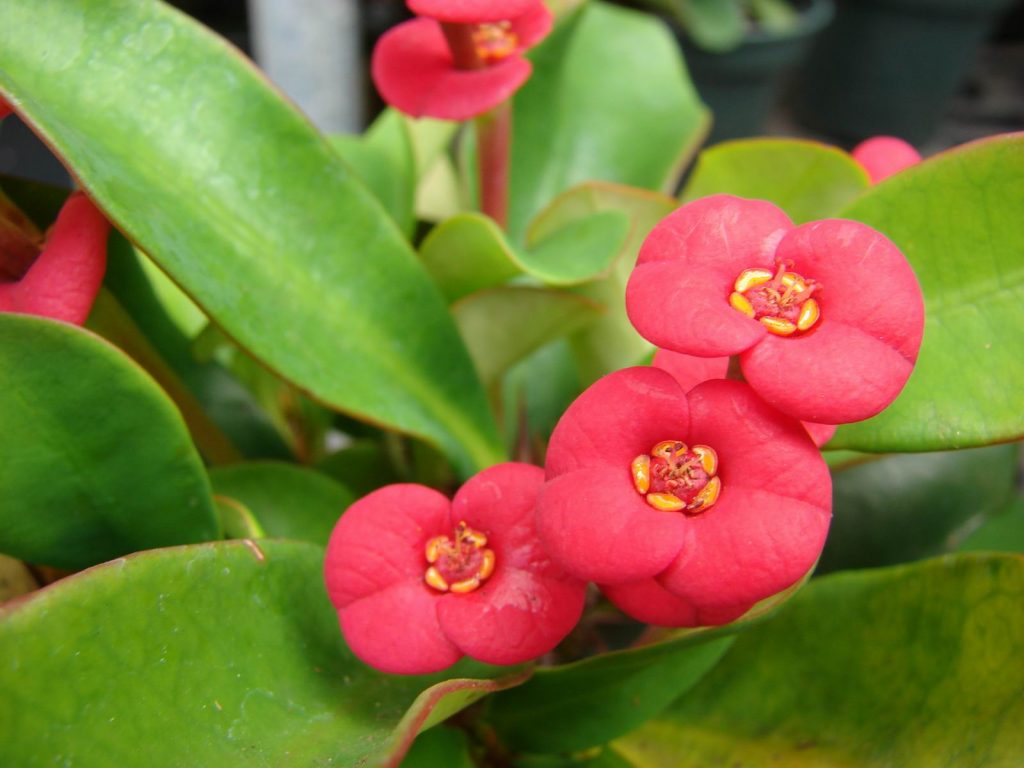
Euphorbia mile reproduction
In the winter season, when the flower enters the dormant stage and the need for moisture decreases, it is watered once a month. At the same time, the ingress of water on inflorescences and leaves is avoided.
It does not tolerate drought well, so you should not allow the earthen coma to completely dry out, which will lead to massive leaf fall. When the moisture regime is restored, the flower quickly returns to normal. Use filtered or separated water at room temperature.
When keeping milkweed in the summer on a balcony or loggia, it is necessary to provide protection from rain. If the Ron is under trees or shrubs, it should be moved under a canopy during rainfall.
Top dressing
Basic care for lustrous milkweed involves regular nutrient supplementation. They use feeding for cacti and succulents. Introduce together by watering once a month throughout the growing season - from spring to autumn.
In the resting phase, food is stopped.
Pruning
Almost all types of indoor milkweed develop a compact and beautiful shape, so there is no need to shape it.
During the growing season, it is necessary to remove yellowed and withered leaves, broken off, dried out and damaged by diseases, pests in time. After the end of flowering, the inflorescences are cut off, which only take away all the strength and energy from the flower.
You can carry out the formation for highly overgrown species - it is allowed to trim the stems growing inside the crown, as well as developing at the wrong angle.
These manipulations are carried out using a sharp and sterile instrument to prevent infection with diseases.
Landing
This procedure is started in the spring before the beginning of the blooming of vegetative buds. Take a pot made of ceramic or plastic with drainage holes. The container is deep and narrow, given the elongated shape of the root system.
A little pebbles or expanded clay are poured at the bottom so that excess moisture does not linger in the soil. Then it is filled with a fertile store or home substrate. The roots are lowered, straightened, the soil is poured to the top, tamped, watered.
Transfer
The purchased plant must be transplanted three weeks after quarantine. If it is a flowering specimen, you need to wait until it fades. When transplanted in the flowering phase, it may not survive stress and die.
First, it is watered, then removed and, together with a lump of earth, transferred into a new flowerpot. If necessary, add the soil to the top, crush it around the stems, and moisten.
House flowers need regular replanting - once every three years. It is also advisable to transplant euphorbia, in which the roots have been damaged by rot, parasites or diseases. The watered plant is pulled out of the flowerpot, dipped into a basin of water to wash off the remnants of the soil. The roots are dried, the infected fragments are cut out, irrigated with a fungicide, then planted in a new pot.
Reproduction methods
At home, you can propagate Mil's indoor spurge in three ways - each gives a positive result when all the rules are followed.
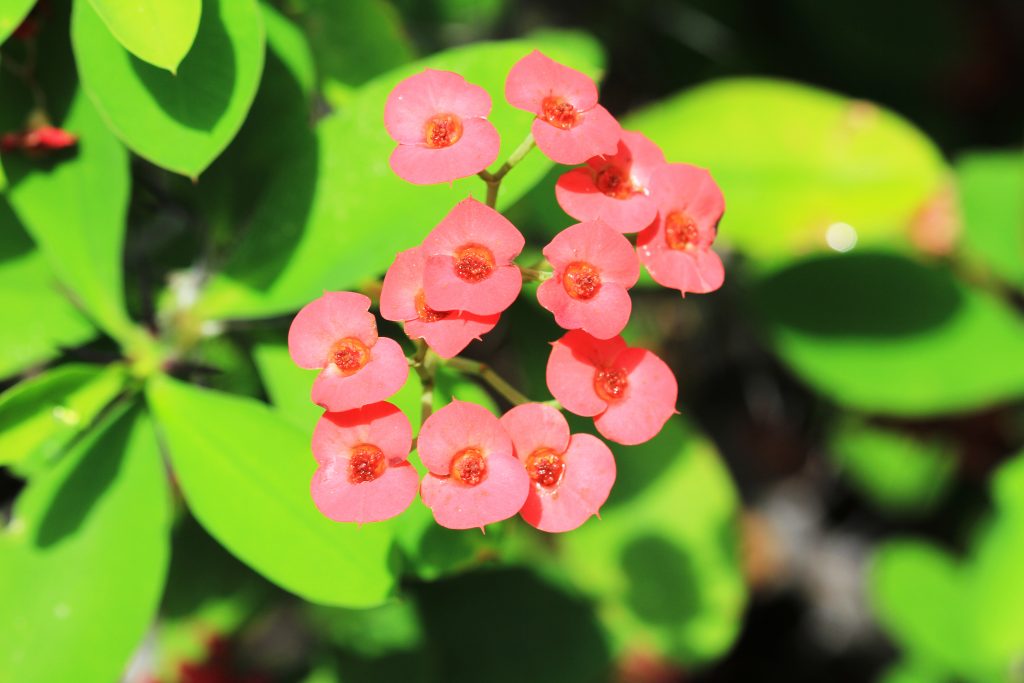
Euphorbia mile care
Cuttings are harvested in the spring - from the beginning of March to the end of May.The shoot is separated from the mother plant, dipped in a vessel with warm water to allow time for the milky juice to drain. After an hour of exposure in such an environment, dry it, sprinkle the lower part with charcoal.
Keep in a dry and well-ventilated area for 2-3 days. As soon as a thin film forms at the cut, the cutting is immersed in Kornevin's solution, then planted in a nutritious substrate of sand, turf and garden soil (1: 1: 1).
For reproduction from cuttings to be successful, the seedlings are moistened, covered with half a plastic bottle, placed in a warm place (temperature - 23-25 ° C) with diffused daylight.
Rooting by cuttings can be considered successful if new leaves appear on them. This can take 2 to 3 weeks. The rooted milkweed is freed from the shelter, they continue to water, after a month of growing, they are seated in separate pots.
Seeds
For planting, use seedling boxes or plastic containers. Seeds are spread on the ground, sprinkled on top with a thin layer of earth, irrigated with a spray bottle.
Then they cover with foil, ventilate every day, spray if necessary. As soon as greenery appears on the surface of the substrate, the shelter is removed, the seedlings are grown until two leaves develop, then they dive separately into small pots.
They are grown for another 2-3 months, after which they are planted in flowerpots in their permanent habitat.
By dividing the bush
There is another option for breeding milkweed mile - by dividing the bush. This method works well for older flowers that need to be rejuvenated.
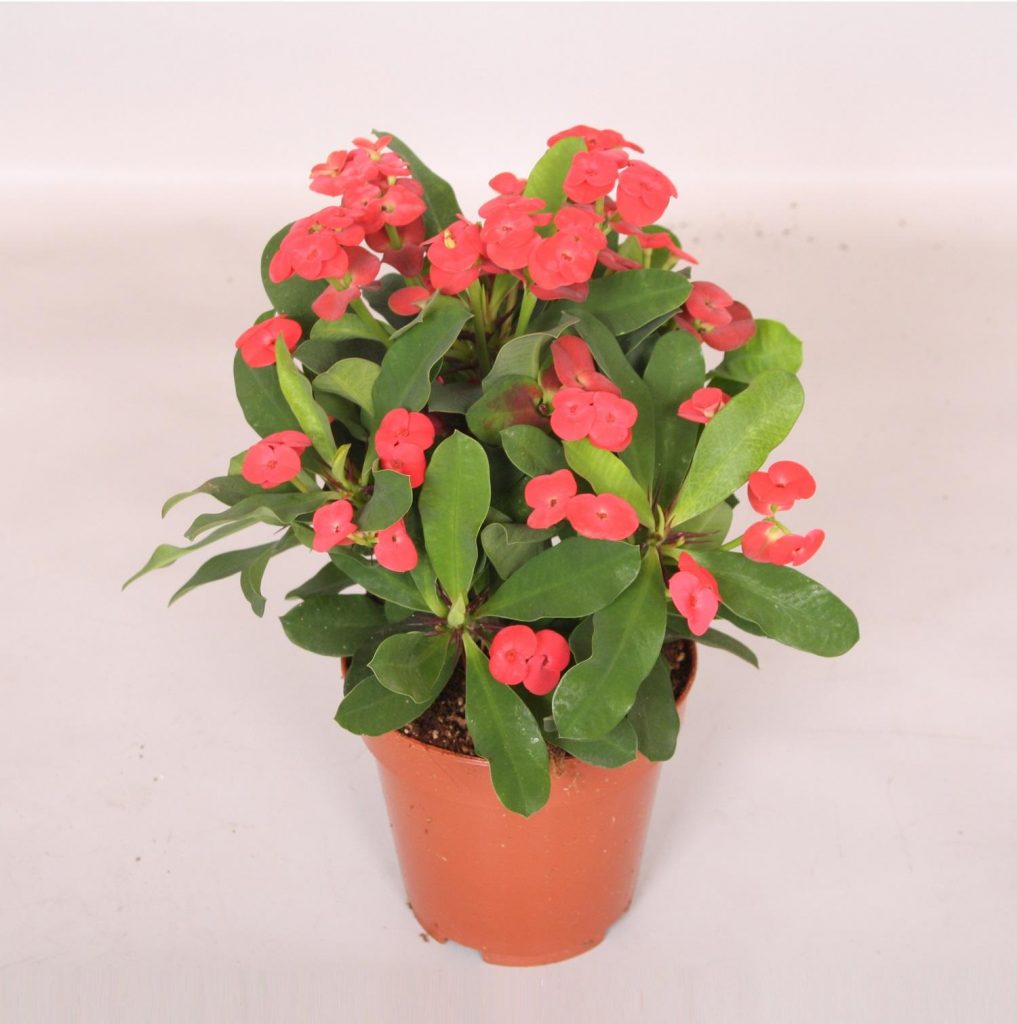
Euphorbia flower mile
The mother plant is watered, removed from the container, carefully examined for root decay and disease damage. All non-viable parts are cut out, then sprayed with a fungicide. After drying, the bush is divided into several parts, so that each has a process with 2-3 roots, leaves and buds.
Delenki are seated separately in new flowerpots with nutritious and loose soil.
Diseases and pests
If this plant is properly looked after, then it will not have health problems. Infections and parasites usually damage weak flowers that do not receive enough light, moisture and nutrition.
| Diseases and pests | Signs | Treatment methods | Prophylaxis |
| Aphid | It settles in colonies on the underside of leaves, feeds on their sap, which leads to curling, drying out and falling off | At the initial stage of the lesion, you can use folk remedies - treatment with a solution of laundry soap, infusion of tobacco or garlic. Launched specimens are treated with pesticides - Karbofos, Aktellik or Fitoverm | Buy healthy flowers, keep in a 3-week quarantine, regularly examine for the invasion of parasites, remove diseased areas on the crown in time |
| Spider mite | These pests appear on milkweed when the air in the room is dry and too hot. They love to feast on the juice of the kidneys, young shoots, leaves, which leads to their deformation, darkening and drying out | Weakly infected flowers are irrigated with soapy water. If the flower is badly damaged, you cannot do without chemistry - treat with Aktellik or Aktara | Increase the humidity, lower the temperature, regularly spray the crown with water |
| Whitefly | Small butterflies of a whitish tone do not pose a danger to this flower, but their offspring - caterpillars gnaw tissues on leaves and buds. The affected areas turn yellow, dry and die off. The plant loses its original decorative appearance | Spill the soil with fungicides - Actellik, Intavir or Fufanon. Also, these funds need to process the crown. | Use a sterile mixture for planting, transplanting, |
| Mealybug | When these pests appear, the flower stops growing, the leaves turn yellow and dry. Usually these parasites accumulate on the roots and feed on their juice. | Euphorbia is watered, pulled out of a flowerpot, washed from soil residues, unviable organs are cut out, dipped in an insecticide solution - Fitoverma, Fundazola. Then transplanted into a new container with disinfected soil | Before planting, sterilize the soil, remove all rotten and yellowed parts in time, regularly inspect for insect infestation |
| Root rot | The appearance of this disease is typical for plants that suffer from frequent overflows of cold water. First, the root system rots, later the rot spreads to the stems - they turn black, become soft and slippery | With a slight lesion, the roots are removed from the container, the diseased parts are cut out, and immersed in a fungicide solution for an hour. Then they are dried, transplanted into a new pot with disinfected soil. Euphorbia, in which all the roots have rotted, is disposed of, but before that, several cuttings are cut for further rooting. | Observe the watering regime, use warm water for humidification |

